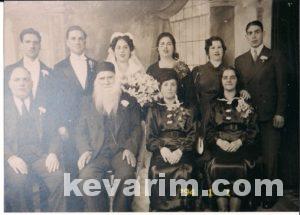Rabbi Chaim Eliyahu Cassorla
חיים ב"ר אליהו
Chief Rabbi of Monastir, Yugoslavia (Macedonia)Date of Death:
Fri. April 17, 1953 -
Iyar 2 5713
Anyone with biographical information is asked to please send it in.
See CONTACT page for details. Thank you.
Directions to Kever: Beth David Cemetery in Elmont, NY maintains computerized records and will provide a detailed location map upon request. Location: Needed
Biographical Notes:
« Previous: Rabbi Avroham Yitzchok AlcalayNext: Rabbi Yehuda Yehoshua Falk Israelite »





One small correction is that Rav Cassorla was the Rav of Monastir, Yugoslavia (current day Macedonia) and not of Monastir, Tunisia.
Thank you for this wonderful and helpful site.
Corrected.
My family has a website with a lot of information, here is some information on him:
[Rabbi]*HaimOf blessed memory. Died 2 Iyar 5713, 17 April 1953ce. (Haham Bohor) Elias Cassorla -m. *Vida(Hava/Victoria/Evelyn)Of blessed memory Pesso
First-born (Bohor) of Eliás. Having been the Rosh Av Bet Din of Monastir, he was known–and always addressed–as Haham Bohor by everyone, even close relatives. He served as an auxiliary chaplain and religious authority for the army under the Ottomans as well as under the Serbian and Yugoslavian governments. As such he was called during Ottoman times a Haham Bashí. His children always addressed him as Señor Padre. His grandchildren, of course, called him Papú.
His wife Vida, was called Nonna by all her grandchildren.
[ Go ]Vida was a daughter of Yaacov and Rachel Pesso of Monastir.
Family lore has it that Vida was promised to Haim on the day he was born. (She was two years old at the time.) In those days it was quite common for babies not to survive the birthing process. Apparently, when he was born, he was so quiet and still, that the midwife thought he would not live, and put him aside. When Rachel Pesso came to attend to her friend Miriam, the midwife indicated the babe. She went over to see him and could tell that he was alive, and exclaimed that he was a fit groom for her own child, Vida. So these two, whose names both mean “life” were married when they were of age.
The family lived at Gostivarska Ulitsa 9. When they left, Eliahu and his family continued to live in the house.
Haham Bohor Cassorla emigrated to the US in 1930 with his wife, and three of his children-all single at the time: Rachel, Moshe, Yosef. They traveled overland first to Belgrade, for an audience with the King–arranged by the Haham Bashí of the country, Dr Isaac Alcalay (who would later emigrate also, and become the Chief Rabbi of the Sepharadim in the US). Then by train via Bern, Switzerland to Le Havre, France. Thence, aboard the SS Ile de France to Ellis Island. They proceeded to Rochester to join his son Jack who had settled among a large community of emigrants from Monastir there. Haham Bohor was employed as the Rabbi and Hebrew School teacher of the Sephardic community in Rochester for some years. Afterwards, they relocated to New York City, which they never left. Jack and his family stayed in Rochester.
Haham Bohor was a scholar and religious leader whose opinion was sought from afar, fluent in several languages–but never learnt English, even after some 23 years in l’America as he called it. He died a widower on the 2nd of Iyar 5713 (17 April 1953) in the Sephardic Home for the Aged, in Brooklyn.
source: http://www.cassorla.net/El_Cass.html
From Last Century of a Sephardic Community: The Jews of Monastir 1839-1943, by Mark Cohen:
“Because Yugoslavia provided a stipend that supported rabbinical salaries, rabbis had to possess certain professional qualifications to become chief rabbi of a town. These included a university degree and formal rabbinic training, and it was probably these criteria that prevented Monastirlis from becoming chief rabbis in Monastir during the 1920’s and 1930’s. Only in between 1928 and 1930, when the community was without an officially appointed chief rabbi, did a Monastirli, Chacham Bechor Chaim Eliyahu Cassorla, serve the community as chief rabbi. In 1930, Chacham Cassorla left Monastir for Rochester, New York, to establish for the Monastirlis there a Talmud Torah school.” (pg 159)
“Monastir’s beit din also functioned after the war (WWI), and its rulings were recognized by the Yugoslav state in matters relating to marriage and divorce. Aside from this limited legal authority, it also enforced local standards of religious behavior. In the 1920’s a Monastirli named Demayo kept his store open on Shabbat despite warnings from Rabbi Bechor Chaim Cassorla, who headed the beit din, that the store must be closed on Shabbat. After repeated warnings, [Rabbi] Cassorla ordered that Demayo’s store by put under cherem. That is, the store was excommunicated. Notices were posted outside all of the city’s five synagogues advising Jews not to shop in the store under any circumstances. The cherem was obeyed, and Demayo had to close his store on Shabbat or go out of business. [Rabbi] Cassorla also levied a fine on Demayo, who was ordered to donate clothing to the Malbish Arumim (Clothe the Naked) fund, which provided clothes to the poor twice a year, at Passover and Rosh Hashana.” (pg 149)
Shalom I am a great grandson of Rabbi Cassorla
I have a few pictures I would like to add to this site. Please contact me
Tizku lemitzvos
Shalom
The pictures i sent you, you never posted
Bonjour je suis a la recherche de ma genealogie je m’appelle Moshé cazorla